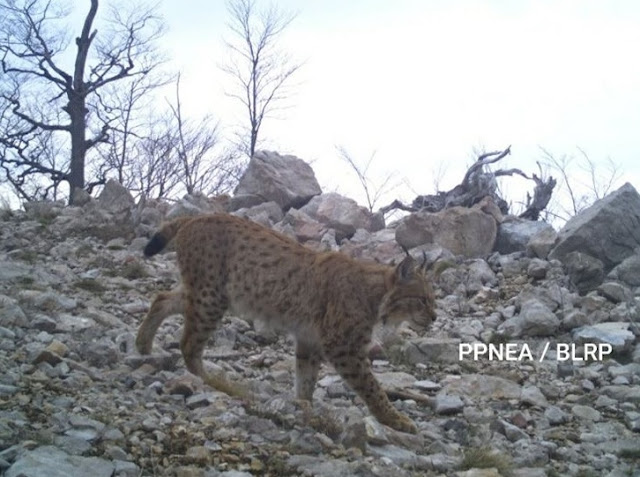 |
| Lynx photographed on Guri i Zi Mount in Elbasan |
Trap cameras are among the most used by wildlife exploration groups and researchers. It is with these cameras that Protection and Preservation of Natural Environment in Albania (PPNEA) has photographed the lives of wild animals on Munella Mountain.
 |
| Lynx photographed on Mount Munella |
The photos show also the Balkan Lynx, an endangered species, but a reproduction of them has recently been seen that raises hopes that the number of this species could increase.
 |
| The wolf (Canis lupus) photographed on Mount Munella |
The Balkan lynx has an outward appearance like all other members of the Lynx genus. The body size is slightly smaller than that of the Eurasian lynx. It is a cat with long legs and robust. The fur is yellowish-brown in Summer, fainter in Winter, more variegated on the legs, but with fewer spots on the back.
The spots may be pale and fused into an almost rosette shape, giving the impression of being large; they vary in size, shape, and color intensity.
 |
| The European rabbit (Oryctolagus cuniculus) photographed on Mount Munella |
Have a relatively small head, long legs, and a very short tail with a black tip. Their faces are short and round, with a characteristic "beard" on both sides, which stands out especially in adults, and the triangular ears end in a black tassel. The feet are wide (about 10 cm), and the toes hide the claws inserted inside. Head and body length vary to 80–130 cm. Tail length vary to 11–25 cm. Leg length 19-22.5 cm. Height at the shoulders 60–75 cm. Weight about 18–25 kg.
 |
| The European roe deer (Capreolus capreolus) photographed on Mount Munella |
Full post by ‘Protection and Preservation of Natural Environment in Albania:
 |
| Fox (Vulpes vulpes) photographed on Mount Munella |
Monitoring of the Balkan lynx for 2020 began on Mount Munella, with the activation of the box-trap and the placement of cameras in the area around it. The research group of 'Protection and Preservation of Natural Environment in Albania PPNEAs activated the trap box in February 2020 and remained active until March 21, 2020. Due to the situation created by COVID-19, the trap box was deactivated before the scheduled time of the study, without having the opportunity to capture a lynx and equip it with GPS. Despite this, our cameras brought the Lynx pictures again to show us that he is the king of animals in that area.
 |
| The European badger (Meles meles) photographed on Mount Munella |
The surprise of this monitoring season was the Lynx family photographed in the Polis-Gur i Zi study area, Elbasan region. PPNEA in close cooperation with AdRZM Elbasan conducted extensive monitoring with trap cameras in this region (Polis-Guri i Zi and Rrajca), for a period of three months (February-April 2020). This monitoring also marked the return of PPNEA in the Elbasan region since 2012, the year in which our group of researchers photographed for the first time the lynx in the Shebenik-Jabllanicë National Park.
The images in which we see the presence of more than one individual in a photo confirm clearly the second population of the Balkan lynx in Albania after that of Munella, as well as the third in the entire Balkan Peninsula. Photographing and filming the three lynxes in a photo/video has been such much-anticipated and sought-after news by the PPNEA group of researchers.
 |
| The wild boar (Sus scrofa) photographed on Mount Munella |
The existence of endangered species in the above-mentioned areas requires coordinated initiatives undertaken with institutions responsible for nature protection. It is important to emphasize here the proclamation of Munella Protected Area as soon as possible and the expansion of the current areas where the lynx is located.
 |
| The jackal (Canis aureus) photographed on Mount Munella |
In addition to Lynx, our cameras have photographed other species of mammals, equally important for their role in the ecosystem, such as the bear (Ursus arctos), the wolf (Canis lupus), the jackal (Canis aureus), the wild boar (Sus scrofa), the European roe deer (Capreolus capreolus), fox (Vulpes vulpes), the beech marten (Martes foina), squirrel (Sciurus vulgaris), the European rabbit (Oryctolagus cuniculus)and the European badger (Meles meles).









